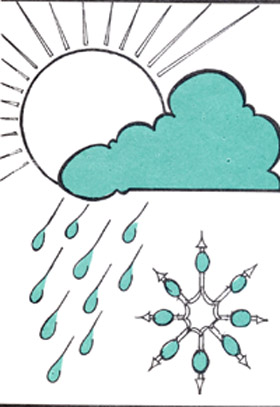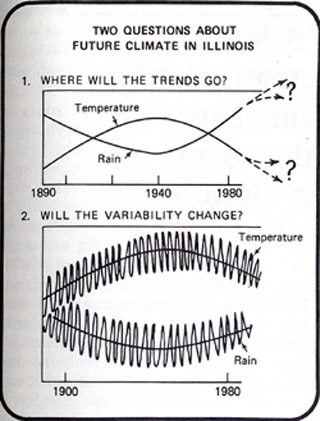 |
Home | Search | Browse | About IPO | Staff | Links |
 |
Home | Search | Browse | About IPO | Staff | Links |
|
Changing climate or not,
weather extremes cost money By STANLEY A. CHANGNON, JR. Using improved methods of statistical analysis, the State Water Survey has concluded that the climate of Illinois is becoming cooler and wetter. The survey's improved forecasting skills are available to government and business to help minimize the impact of changing weather patterns ILLINOIS HAS experienced three record severe winters since 1976, an excessive heat wave in 1980, and a severe drought in 1976-1977. Local and state agencies are very vulnerable to such weather extremes, since they lead to tremendous increases in expenditures for services. Are these weather aberrations temporary, or is the climate changing? If it is, as many scientists believe, should government and industry budget for more weather-related losses and a different climate? Can we predict the weather months and years ahead to better manage our institutions and lives? Scientists at the Illinois State Water Survey have been studying these questions and offer hope that weather extremes can be detected in advance, allowing opportunities to plan for the financial and social problems they cause. 
Let us consider the climate change questions, where confusion abounds. First, the climate of Illinois is changing and has always been changing. Unfortunately, expressions of weather as to departures from "normal" have left the impression that climate is a constant. In fact, our climate, on all time scales from months to centuries, has constantly fluctuated. Tropical forests once grew here, and in other epochs mile-thick glaciers covered northern Illinois. Illinois temperatures (see figure) reveal that we are now in a downward temperature trend, and there is no way to predict whether it will last 10 or 100 or 1,000 years. At the same time, precipitation and cloudiness are increasing. We now receive less sun than at any time since records began in 1900. Another question about climate change relates to variability (see figure). Despite the weather aberrations in Illinois in the late 1970's, Water Survey studies indicate that the state's climate is not becoming appreciably more variable than in the past. What are the impacts of the continuing tendency to wetter and cooler climate, and who is affected? Colder winters will affect our budgets and facilities. With its strong dependence on national and international trade, Illinois has become more climate sensitive during the last 20 years. Extensive requirements for energy, transportation and industrial production, viewed in light of our marginal national resources, put us in a perilous position when the weather swings either to prolonged hot summers as in 1980 or to cold, snowy winters as in 1977, 1978 and 1979. The recent severe winters have had many serious effects. Snow removal in the 1978-1979 winter cost Chicago $72 million. The Chicago populace perceived a lack of adequate preparation for this third record severe winter, a factor partially responsible for a change in the city's administration. Subsequent planning for future winter conditions was elaborate, including expenditure of about $20 million for snow removal equipment. Illinofil utilities have sought rate hikes annually to help adjust for the economic impacts of these winter aberrations. The colder and wetter winters have also led to massive damage to many Illinois roads. At the end of the 1979 winter, the state had 4.2 million potholes and 5,500 court cases over pot hole-induced damages. The repair of added potholes cost the state $11.4 million in 1977-1979, and these unplanned costs further pinched the state road funds. The weight of accumulated snow from excessive winter snowfalls coupled with prolonged cold also brought serious roof and wall damages to 50,000 Illinois homes in 1978-1979, with an average cost of $1,200 per home, or $60 million in total damage. Heat extremes and drought also can I cause great losses. The heat and drought of 1980 reduced state corn yields by 34 percent, representing a multi-million dollar loss reflected in farm income and later in state income tax.
The list of severe losses related to the recent weather goes on and on, but the message is clear: changing weather is creating massive impacts on business, industry, utilities, transportation, local and state government institutions, and ultimately on everyone in Illinois. Can we minimize losses by predicting climate? Historical analogies ("what kind of past years followed others like this one?") occasionally give useful predictive information. More sophisticated analyses of past climate statistics are encouraging. 20/February 1981 /Illinois Issues 
The Water Survey has completed two projects attempting to develop techniques to predict trends in seasonal and annual weather from one to five years in the future. Probabilistic predictions can be very useful, assuming that users develop understanding of the predictive process and how to use the statistical results. The crop-hail insurance industry worked with survey scientists and now plans to utilize the predictive techniques in deciding on future state rate assessments throughout the nation. A cooler and wetter climate will benefit Illinois agriculture but increase problems and costs for city and state governments, transportation systems and the energy industry. What can be done? For one, governmental institutions can prepare themselves for the impacts of the cooler and wetter climate and its extremes by budgeting for higher costs. Those affected by weather extremes and by cooler and wetter conditions can help minimize these costs by utilizing existing predictive capabilities. It behooves the state to consider how to use growing climate forecast skills and to plan for a climate that is slowly getting colder and wetter. Stanley A. Changnon, Jr., is chief, Illinois Slate Water Survey, a division of the Illinois Institute of Natural Resources. February 1981/Illinois Issues/21 |
|
|